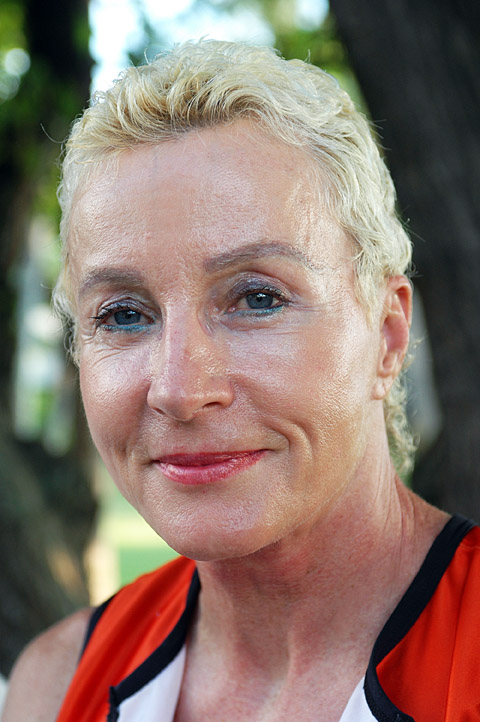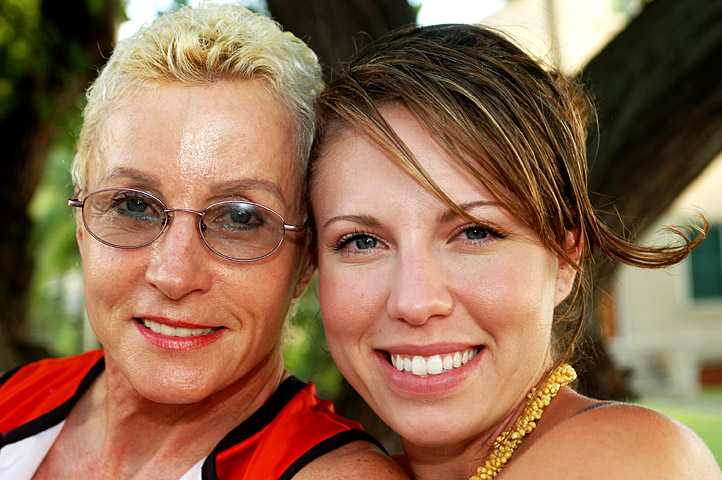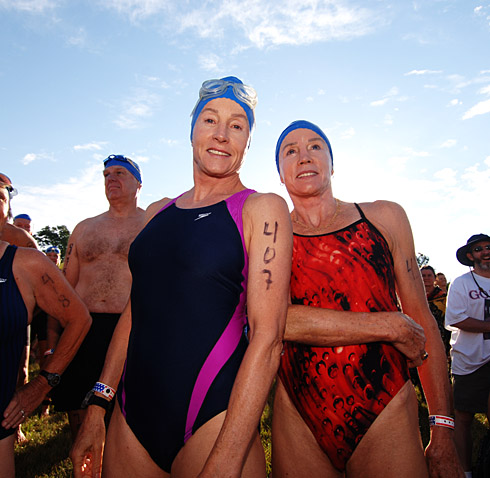Endurance sports legend Barbara Warren dies after Santa Barbara bike accident

Barbara Warren, one of the greatest, most adventurous age group endurance athletes of all time, died Tuesday, August 26 after suffering paralyzing injuries suffered in a bike accident while competing in the Santa Barbara Triathlon on Saturday.
Doctors at a Santa Barbara hospital said Warren, 65, a San Diego area resident for 23 years, broke her ondontoid bone that rests on top of the spine and the C2 vertical vertebrae in a crash on a downhill portion of the hilly, 34-mile bike leg. By Tuesday, doctors determined that her paralysis was permanent.
Kept alive and breathing by a ventilator, Warren communicated later that day by nodding her head and blinking her eyes that she wanted to be taken off the ventilator, said her husband, 1979 Ironman Champion Tom Warren.
“She still had the courage to communicate and (indicated that) she didn’t want to go on like that,” her twin, Angelika Drake, told the San Diego Union Tribune. “She never would have liked that. No athlete would like to have a life with only their eyes talking.”
When Warren died, she was surrounded by her two daughters Ingrid and Katrin, her husband and twin sister.
What she leaves behind is the very model of a life lived to the bursting — in several acts. A PhD in psychology, she left behind a thriving practice in psychotherapy, several motivational books and guides to training, and a generous schedule of motivational seminars and speaking engagements. In her youth, she and her twin sister Angelika studied art history in Italy, moved to Mexico and became famed models and feature film actresses, founded a fashion line and owned four chic boutiques. Not until she turned 40 did she turn to running, triathlon and various forms of adventure racing and mountain climbing.
Most often with her twin sister Angelika, Warren took on the toughest endurance tests on the planet. They ranged from the 9-day Race Across America, a 7-day runs through the African desert, single, double and triple Ironmans, and the toughest weeklong adventure races as well as self assigned long distance challenges.
Barbara Warren was born in 1943, six hours after her twin sister Angelika, in a small town of St. Johann (population 4,000) in the Tirol area of the Austrian Alps, near the Swiss border. “It was a very small, very pretty place,” she said in a 2006 interview. “About 20 miles from where I lived they made The Sound of Music.”
Her father Hans Mueller owned an auto repair shop and several movie theaters. Her mother, Ingrid, was a cross country skier on the Italian Olympic squad and encouraged her five children to have a fearless passion for all sports. “We had a fairy tale childhood,” said Barbara. “I was skiing from the time I was four years old – and rock climbing and mountain climbing and doing all the sports.”
A fairy tale childhood that began in the middle of World War II and stretched well into the post-war occupation most emphatically did not mean it was easy or luxurious. “My father, we did not grow up with him,” said Barbara. “Mother was born in 1914 and was very self-sufficient. She gave us very enhancing, very uplifting messages. So we always knew we could do things. Nothing was too scary to us. She would always say ‘Do it! So go do it!’”
This powerful message was amplified by hard material conditions that Ingrid Mueller taught her twins to transcend and overcome. “We got what we called survival power from the war and post-war,” said Barbara. “We survived with nothing. Winters were very harsh. We would never complain because Mother did not. It really built character. Later, when we were doing long distances, that quality, that kind of past, became very handy.”
In 1960, at the age of 17, the twins left home, the start of a globe trotting adventurous life that would bring them to 65 countries before they settled in San Diego in 1985. First stop was Florence, Italy where they studied art history at the Accademia di belle Arti and worked as fashion models to support themselves. During summers, they took jobs on cruise ships with ports of call in Africa and Saudi Arabia.
In 1965, they decided to continue their art studies in Mexico City. While they soon abandoned art history, their modeling and entrepreneurial careers blossomed — and other glamorous adventures awaited. Angelika and Barbara soon turned into top models. Working with famous Mexican fashion designers, they did shoots for fashion magazines, TV commercials and artistic performances which took them to eight countries. Their modeling careers provided a springboard to own chain of four boutiques – two in Mexico City and one each in Acapulco and Guadalajara. They also founded a model and personal development school in Mexico City which grew to 800 students annually. They opened a modeling agency and their own fashion design house.
During this time, Barbara became a Mexican movie star known as Barbara Angely. Her chilling Austrian accent won her the role as villain in two dozen feature films and guest roles on American TV series “Mission Impossible” and “I Spy.”
Traveling in elite international society, the twins became dissatisfied. As they wrote later in a biographical resume, “The extreme, unnatural lifestyle took a grip on their souls. Neurotic, unsatisfied, and involved in drugs, their lives had to take a turn for their survival.” In almost miraculous fashion, they both found the power, over and over again, to successfully reinvent themselves.
Angelika was chosen by Mexican filmmaker Ramon Bravo to star in a series of adventure documentaries which often placed her in precarious underwater situations such as swimming with hammerhead sharks and diving to depths of 100 meters. Angelika also worked as a stunt double for Farrah Fawcett in the 1979 feature film “Sunburn.” Barbara on the other hand, made an abrupt, unexpected retirement from film, declaring on a Mexican entertainment news program: “This is the last time you will see me.”
Both twins grew frustrated with their inability to lead their lives of their own. As part of the process of self realization, they began a study of a multitude of religions — and had a session with a parapsychologist. “It was very exciting,” Barbara told the Los Angeles Times. “Things (were) moving around.” They also found some answers in traditional psychotherapy.
In the late ‘70s, they both married and found some needed distance from one another. Barbara wed Mexico City importer Armando Alvarez, whose uncle was President of Mexico, and Angelika married Henrique Castaneda, a men’s clothing manufacturer. Both had children – Angelika two boys, Barbara two girls.
In 1980, Barbara and her husband and children moved to Brownsville, Texas, where she continued her studies for a graduate degree in psychology, which she had begun in Mexico City. This began a four year period of separation. Still, the uncanny spiritual and psychological link the twins shared could not be broken. Later they told the Los Angeles Times they bought the same set of china, the same blouse and the same pair of shoes virtually simultaneously while living thousands of miles apart.
In 1983, Barbara did one thing quite on her own. At 40, she joined the running revolution. Angelika, who had remained in Mexico City to oversee the twins’ businesses, did not join in her sister’s latest enthusiasm immediately. But after Angelika moved with her family to the multisport mecca of San Diego in 1985, she grew receptive to Barbara’s new passion.
By late 1985, Barbara and her family joined Angelika and her family in San Diego. In their first six months back together, the twins ran 43 miles across the Grand Canyon and back, cycled 112 miles in Arizona, ran two marathons, two 50-mile ultra marathons, a bunch of 10ks, and were on their way to endurance sports legend

As they suffered the inevitable aches and pains of their uber-mileage, they naturally discovered cross training.
In San Diego, said Barbara, “We started open water swimming, and then biking was natural because of all the triathletes in the San Diego area riding up and down the coast highway. We joined runners, masters swimmers, and the Cyclo-Vets and rediscovered the everyday joy in sport we had as children. It became part of our identity. We saw how much joy it gave to our friends, and we didn’t want to miss out.”
In 1987, they took on their first triathlon, an Olympic distance event in Mission Viejo. “Once we decided to do this triathlon, we only had two months,” recalled Barbara. “We went to this race just enormously nervous because of the unknown. We had run many marathons, but the swim and bike were so new. Because we had no heated pools and never had bikes growing up, we were scared. We remembered growing up we had been downhill racers and the night before you had a huge fear because in downhill the fall was bad. But as our mother taught us, this was something to overcome and slice through.”
By 1988, Barbara and her sister took on their first Ironman Hawaii, ignored the clock and spent much of their day giving hugs and ‘Hi’s’ to friends. After that, Barbara and Angelika got serious and adopted scientific methods of training and got progressively better. Barbara did 12 more Ironman Hawaiis – winning the 60-64 age group title in 2003 in 13:35:44.
While for many the Ironman would be the pinnacle of athletic challenge, it was just a warm up for the twins. In the next two decades, they did almost everything imaginable. In 1988 and 1990, they finished the Western States 100 trail run, which they remembered not for their times but for the hallucinations it provoked. “Little men up in trees,” said Angelika. “I saw them too,” said Barbara.
In 1989, the Twins finished the 146-mile Badwater to Mt. Whitney run in a then-record 50 hours. In 1990, tricked into sleeping only 90 minutes by their crew, they smashed that mark and finished in 39 hours. In 1990, they finished 1-2 among women at the three-day, 520-mile Ultraman Triathlon in Hawaii, finished second and third women in the 7-day, 140-mile, self-supported Marathon Des Sables through the Moroccan desert. In 1991, they finished the a double Ironman in Alabama and in 1992 set a record of 46 hours to finish the Triple Ironman in France. In 1994, they did both the Raid Gauloises and the Eco-Challenge expedition length adventure races and in 1995, survived the first Extreme games adventure race in 120-degree conditions in Baja Mexico.
In 1996, on a plane ride home from Ironman Hawaii, she met 1979 Ironman Hawaii champion Tom Warren and invited him to a San Diego post-Ironman party. Barbara said she had reservations about meeting the former Pacific Beach tavern owner, but was won over by their first date the next morning. “We ran from Del Mar to Oceanside,” she recalled. When we were done, then I just knew. Case closed, End of story, I was in love with him.”
In 1997, the twins became the first women to make a solo 350-mile crossing on foot and raft from Homer to Hope in the Alaska Wilderness Classic. In 1999, they won their age group in the Mt. Taylor Quadrathlon a bike-run-snowshoe-ski event in New Mexico. In 2000, they invented the Twin Team Quadrathlon Extreme in which Barbara supported Angelika, who biked 110 miles from San Diego to San Pedro, swam 23 miles to Catalina Island, ran 50 miles around the island, kayaked 23 miles back to the mainland, and biked 110 miles home in a grand total of 49 hours.
In 2001, the twins were the first two-women team to conquer cycling’s 2,900-mile Race Across America, in 9 days and 13 hours. Just 65 miles from the finish, Angelika was hit by a car and suffered a separated shoulder, torn ligaments, broken ribs and a badly bruised knee. And so when fear of paralysis was allayed, Barbara took off and finished the Twins’ race.
In 2002, the Twins and several of their children climbed 19,342-foot Mt. Kilimanjaro in Africa on the tough Umbwe route. That same year they also set a record of 23 hours climbing Mt. Whitney twice on a mountaineering route.
During all these adventures, Barbara counseled hundreds of people in her psychology practice in San Diego and in seminars and motivational books like Unleash the Power to Complete Your Goals and Become Exceptional. And the curiously titled Do What You Don’t Want to Do. Drawing from her sporting experiences and from her mother’s encouragement, she tried to pass many of those lessons on to her clients in therapy. “I tell people to go out and test their potentials which they are so afraid of,” she told the Los Angeles Times. “There is no victory without battle. Touch the limits. Stretch yourself. This is what gets you to a better quality of life. I’ve learned that I’m much greater than I thought that God has given me a talent which I have to use.”
Sports, she said, “make us overcome the obstacles, the adversity. While we pay a high price for high goals, we have learned capacities – for tolerance to frustration and the capacity to delay gratification. Ultimately, those two things help me to have a higher quality of life. And another thing – I choose stress. It doesn’t choose me. Racing, competing and training can be at times very stressful. But it is a healthy stress that extends neurons in the brain and expands everything in the body.”

In casual conversation and countless interviews, the Twins took great pleasure in discerning the subtle strengths and individual quirks and characteristics that mark their independence.
In a 1990 Sports Illustrated article, Angelika says “I was born first. So I had to push and shove. She just slipped out and so has always had more strength than me.”
In another great exchange in that article, Angelika said “I am the courageous one.” Barbara nodded and added “But I am the strong one.” Angelika countered. “She is a mule, but she is not so sensitive. I cry at sunsets” Barbara: “She is more dramatic, but I am the talkative one.”
Given Barbara’s psychology training, she was appreciatively analytical about the relationship she enjoyed with her twin and her second, lasting marriage to 1979 Ironman Hawaii winner and Ironman Hall of Famer Tom Warren. “Tom is an emotional person,” she explained. “He is very open. He talks to everyone. His friends know all the ins and outs of his life. He is very transparent. I am less emotional than he is — less on the surface. He has very deep emotions and in this way he is like my twin sister. She married a man (Drake) who is like me. Nature leads us to want what we don’t have. That's how chemistry works. It’s funny that way. It’s obvious to people who know us that we each married mirrors of each other’s twin. We are opposites already, and who we marry is, of course, in essence, the other twin.”
And so on Tuesday, when doctors determined that she would be permanently paralyzed, Barbara communicated to Angelika by blinking her eyes that she wanted to be taken off the ventilator that kept her alive.
Angelika said she lay next to her sister when she died.
“My heart and soul are gone,” said Angelika. “She was everything in my life.”


Start the discussion at slowtwitch.northend.network